In
our pilot examine, we draped a slender, versatile electrode array over the surface of the volunteer’s brain. The electrodes recorded neural indicators and despatched them to a speech decoder, which translated the signals into the terms the gentleman supposed to say. It was the initial time a paralyzed individual who couldn’t communicate had made use of neurotechnology to broadcast whole words—not just letters—from the brain.
That trial was the fruits of a lot more than a 10 years of investigation on the underlying mind mechanisms that govern speech, and we’re enormously very pleased of what we’ve attained so far. But we’re just getting commenced.
My lab at UCSF is working with colleagues all-around the entire world to make this technological innovation protected, steady, and dependable sufficient for everyday use at residence. We’re also doing the job to increase the system’s performance so it will be truly worth the hard work.
How neuroprosthetics function
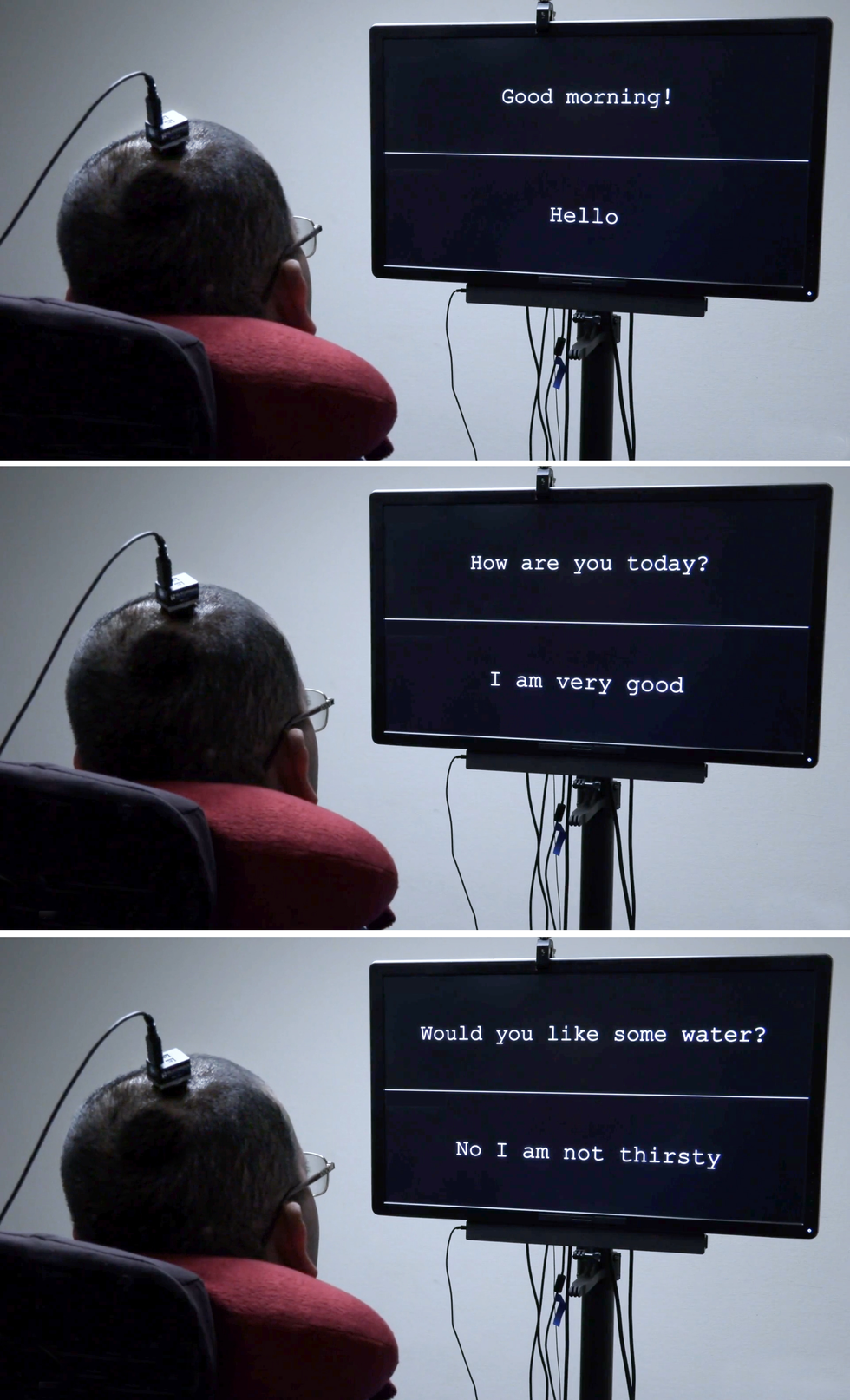 The to start with version of the mind-personal computer interface gave the volunteer a vocabulary of 50 functional words and phrases. University of California, San Francisco
The to start with version of the mind-personal computer interface gave the volunteer a vocabulary of 50 functional words and phrases. University of California, San Francisco
Neuroprosthetics have occur a prolonged way in the previous two many years. Prosthetic implants for hearing have advanced the furthest, with patterns that interface with the
cochlear nerve of the internal ear or straight into the auditory brain stem. There is also substantial exploration on retinal and mind implants for vision, as well as initiatives to give folks with prosthetic fingers a feeling of touch. All of these sensory prosthetics consider facts from the outside the house environment and convert it into electrical alerts that feed into the brain’s processing facilities.
The opposite variety of neuroprosthetic data the electrical action of the mind and converts it into alerts that command something in the outdoors planet, these as a
robotic arm, a video-game controller, or a cursor on a computer display screen. That previous control modality has been employed by teams such as the BrainGate consortium to enable paralyzed folks to sort words—sometimes a single letter at a time, in some cases applying an autocomplete function to velocity up the course of action.
For that typing-by-brain functionality, an implant is ordinarily put in the motor cortex, the element of the mind that controls motion. Then the user imagines particular physical actions to control a cursor that moves around a virtual keyboard. One more tactic, pioneered by some of my collaborators in a
2021 paper, experienced a person person think about that he was keeping a pen to paper and was creating letters, creating alerts in the motor cortex that were translated into text. That tactic established a new file for pace, enabling the volunteer to generate about 18 phrases for each minute.
In my lab’s exploration, we have taken a more bold strategy. Instead of decoding a user’s intent to transfer a cursor or a pen, we decode the intent to management the vocal tract, comprising dozens of muscles governing the larynx (frequently known as the voice box), the tongue, and the lips.
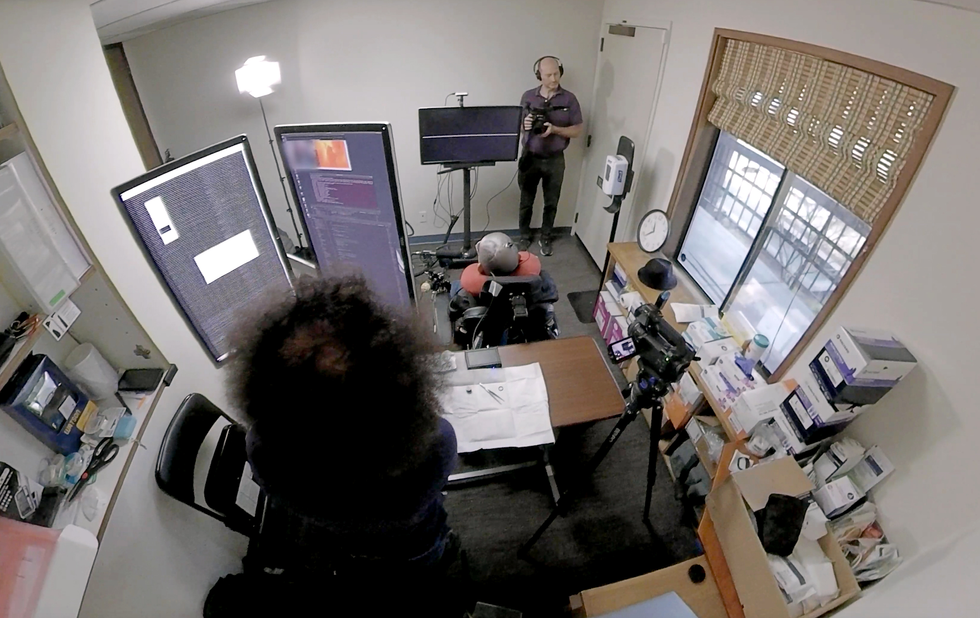 The seemingly easy conversational setup for the paralyzed guy [in pink shirt] is enabled by the two sophisticated neurotech hardware and equipment-mastering systems that decode his mind indicators. University of California, San Francisco
The seemingly easy conversational setup for the paralyzed guy [in pink shirt] is enabled by the two sophisticated neurotech hardware and equipment-mastering systems that decode his mind indicators. University of California, San Francisco
I commenced doing work in this area far more than 10 a long time ago. As a neurosurgeon, I would usually see sufferers with critical accidents that still left them unable to discuss. To my shock, in several instances the spots of mind accidents did not match up with the syndromes I uncovered about in healthcare college, and I realized that we nonetheless have a lot to master about how language is processed in the brain. I determined to study the fundamental neurobiology of language and, if attainable, to establish a mind-equipment interface (BMI) to restore conversation for men and women who have shed it. In addition to my neurosurgical history, my workforce has know-how in linguistics, electrical engineering, personal computer science, bioengineering, and drugs. Our ongoing medical demo is testing both of those hardware and application to check out the restrictions of our BMI and establish what kind of speech we can restore to individuals.
The muscle mass included in speech
Speech is 1 of the behaviors that
sets individuals aside. A good deal of other species vocalize, but only humans mix a established of appears in myriad different approaches to depict the planet close to them. It is also an terribly complicated motor act—some experts feel it is the most intricate motor action that men and women carry out. Talking is a solution of modulated air flow via the vocal tract with each and every utterance we form the breath by developing audible vibrations in our laryngeal vocal folds and changing the shape of the lips, jaw, and tongue.
Lots of of the muscular tissues of the vocal tract are pretty compared with the joint-primarily based muscular tissues these types of as individuals in the arms and legs, which can transfer in only a few prescribed ways. For example, the muscle mass that controls the lips is a sphincter, although the muscles that make up the tongue are governed extra by hydraulics—the tongue is largely composed of a fastened quantity of muscular tissue, so going a person element of the tongue adjustments its form elsewhere. The physics governing the movements of such muscle groups is fully diverse from that of the biceps or hamstrings.
Mainly because there are so quite a few muscle groups involved and they each individual have so several degrees of flexibility, there is fundamentally an infinite amount of probable configurations. But when individuals converse, it turns out they use a relatively tiny set of core actions (which vary considerably in unique languages). For instance, when English speakers make the “d” sound, they set their tongues guiding their tooth when they make the “k” audio, the backs of their tongues go up to touch the ceiling of the again of the mouth. Couple people today are conscious of the specific, complex, and coordinated muscle mass steps required to say the simplest term.
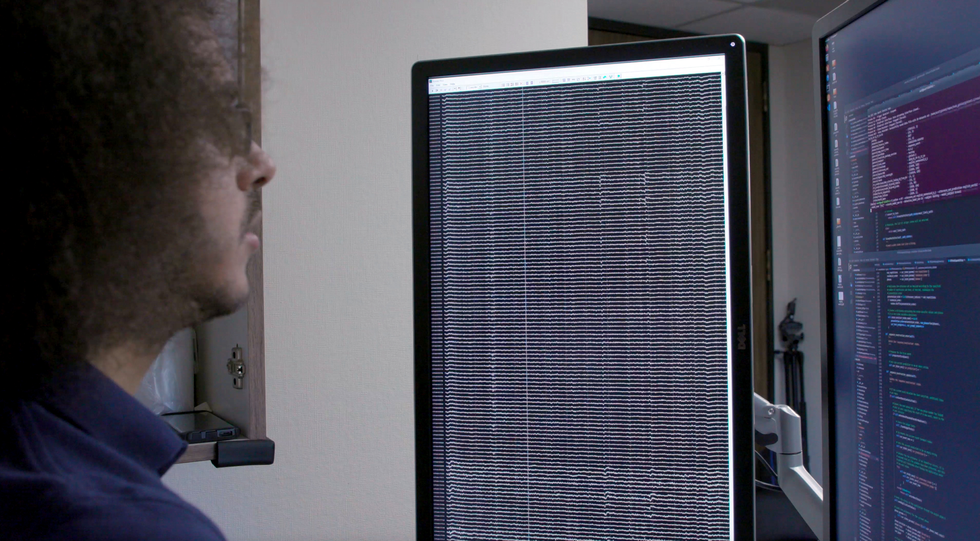 Workforce member David Moses looks at a readout of the patient’s mind waves [left screen] and a display of the decoding system’s action [right screen].College of California, San Francisco
Workforce member David Moses looks at a readout of the patient’s mind waves [left screen] and a display of the decoding system’s action [right screen].College of California, San Francisco
My investigation group focuses on the parts of the brain’s motor cortex that send out motion commands to the muscles of the facial area, throat, mouth, and tongue. All those brain regions are multitaskers: They take care of muscle movements that generate speech and also the movements of people exact muscle tissue for swallowing, smiling, and kissing.
Learning the neural action of all those regions in a useful way involves equally spatial resolution on the scale of millimeters and temporal resolution on the scale of milliseconds. Traditionally, noninvasive imaging programs have been able to present a single or the other, but not both equally. When we commenced this analysis, we discovered remarkably minimal data on how brain activity styles had been related with even the most straightforward factors of speech: phonemes and syllables.
Listed here we owe a credit card debt of gratitude to our volunteers. At the UCSF epilepsy heart, people preparing for surgical procedure typically have electrodes surgically placed about the surfaces of their brains for a number of times so we can map the locations concerned when they have seizures. For the duration of individuals couple times of wired-up downtime, quite a few people volunteer for neurological research experiments that make use of the electrode recordings from their brains. My group asked sufferers to allow us study their designs of neural activity whilst they spoke phrases.
The components involved is known as
electrocorticography (ECoG). The electrodes in an ECoG program do not penetrate the brain but lie on the area of it. Our arrays can comprise various hundred electrode sensors, each and every of which data from hundreds of neurons. So much, we have used an array with 256 channels. Our goal in those people early scientific tests was to find the styles of cortical activity when individuals communicate easy syllables. We questioned volunteers to say unique sounds and words while we recorded their neural designs and tracked the movements of their tongues and mouths. Sometimes we did so by obtaining them use colored encounter paint and utilizing a personal computer-eyesight process to extract the kinematic gestures other times we employed an ultrasound device positioned under the patients’ jaws to graphic their transferring tongues.
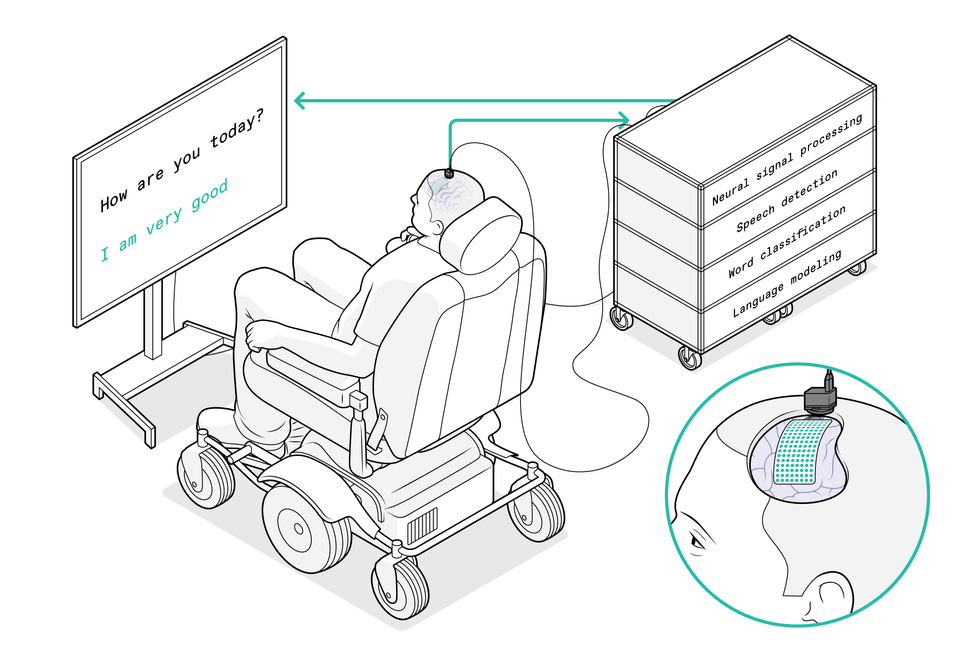 The system commences with a versatile electrode array that is draped in excess of the patient’s mind to choose up alerts from the motor cortex. The array precisely captures movement instructions meant for the patient’s vocal tract. A port affixed to the cranium guides the wires that go to the personal computer method, which decodes the mind alerts and translates them into the words that the affected person wants to say. His responses then show up on the exhibit screen.Chris Philpot
The system commences with a versatile electrode array that is draped in excess of the patient’s mind to choose up alerts from the motor cortex. The array precisely captures movement instructions meant for the patient’s vocal tract. A port affixed to the cranium guides the wires that go to the personal computer method, which decodes the mind alerts and translates them into the words that the affected person wants to say. His responses then show up on the exhibit screen.Chris Philpot
We applied these units to match neural designs to actions of the vocal tract. At initial we experienced a good deal of queries about the neural code. A single possibility was that neural action encoded directions for specific muscle tissue, and the mind basically turned these muscle tissues on and off as if urgent keys on a keyboard. Yet another thought was that the code identified the velocity of the muscle contractions. Yet a different was that neural exercise corresponded with coordinated designs of muscle mass contractions utilized to develop a sure audio. (For case in point, to make the “aaah” seem, equally the tongue and the jaw will need to fall.) What we found was that there is a map of representations that controls various elements of the vocal tract, and that alongside one another the various brain parts merge in a coordinated way to give increase to fluent speech.
The position of AI in today’s neurotech
Our function is dependent on the advances in synthetic intelligence about the earlier ten years. We can feed the details we gathered about each neural action and the kinematics of speech into a neural community, then allow the device-finding out algorithm uncover patterns in the associations in between the two data sets. It was doable to make connections among neural activity and manufactured speech, and to use this design to produce pc-created speech or textual content. But this system couldn’t teach an algorithm for paralyzed men and women for the reason that we’d absence 50 percent of the data: We’d have the neural designs, but very little about the corresponding muscle mass actions.
The smarter way to use equipment discovering, we recognized, was to crack the difficulty into two methods. Very first, the decoder translates indicators from the brain into intended movements of muscle groups in the vocal tract, then it interprets individuals supposed movements into synthesized speech or textual content.
We simply call this a biomimetic solution simply because it copies biology in the human overall body, neural exercise is straight responsible for the vocal tract’s movements and is only indirectly accountable for the sounds created. A huge benefit of this approach comes in the coaching of the decoder for that 2nd step of translating muscle movements into sounds. For the reason that people relationships in between vocal tract movements and seem are pretty common, we were being ready to coach the decoder on huge knowledge sets derived from persons who weren’t paralyzed.
A scientific trial to test our speech neuroprosthetic
The up coming massive problem was to carry the technology to the persons who could truly profit from it.
The Nationwide Institutes of Overall health (NIH) is funding
our pilot demo, which commenced in 2021. We now have two paralyzed volunteers with implanted ECoG arrays, and we hope to enroll far more in the coming yrs. The principal aim is to increase their communication, and we’re measuring performance in terms of text per moment. An regular grownup typing on a total keyboard can form 40 words and phrases for every moment, with the quickest typists reaching speeds of far more than 80 terms for every minute.
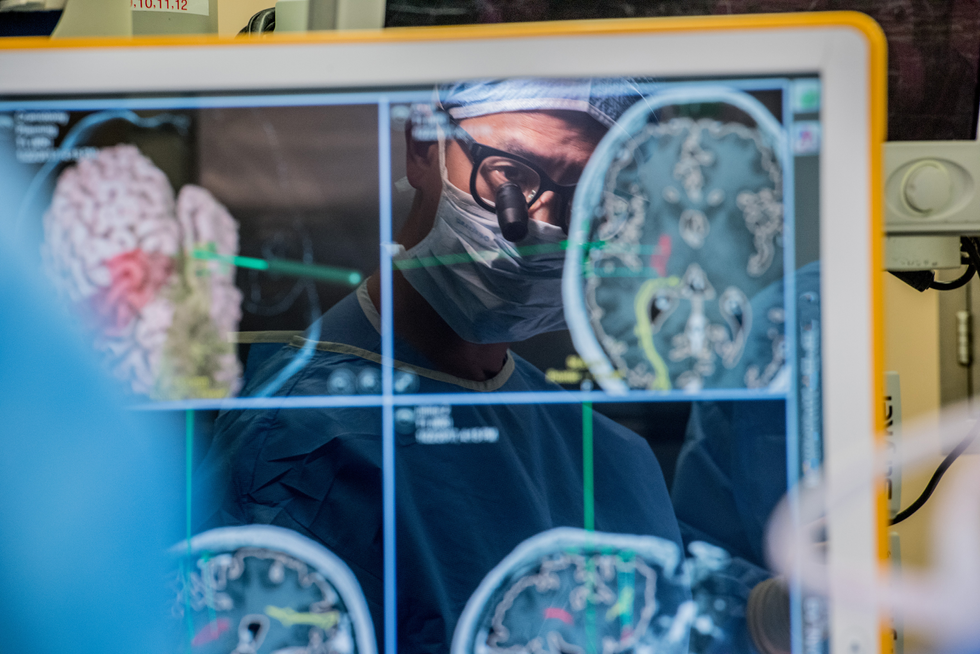 Edward Chang was impressed to develop a mind-to-speech technique by the clients he encountered in his neurosurgery exercise. Barbara Ries
Edward Chang was impressed to develop a mind-to-speech technique by the clients he encountered in his neurosurgery exercise. Barbara Ries
We consider that tapping into the speech program can present even better success. Human speech is significantly speedier than typing: An English speaker can conveniently say 150 words and phrases in a moment. We’d like to enable paralyzed individuals to converse at a charge of 100 phrases for every minute. We have a whole lot of operate to do to reach that objective, but we feel our tactic can make it a feasible concentrate on.
The implant treatment is program. 1st the surgeon eliminates a smaller part of the skull future, the adaptable ECoG array is carefully put across the floor of the cortex. Then a modest port is preset to the skull bone and exits by a separate opening in the scalp. We presently require that port, which attaches to exterior wires to transmit details from the electrodes, but we hope to make the process wi-fi in the future.
We have regarded making use of penetrating microelectrodes, for the reason that they can report from scaled-down neural populations and may perhaps as a result offer far more depth about neural action. But the recent components is not as sturdy and risk-free as ECoG for clinical applications, specifically over a lot of many years.
One more thought is that penetrating electrodes normally require daily recalibration to turn the neural indicators into obvious commands, and study on neural units has revealed that speed of setup and general performance dependability are critical to finding persons to use the technology. That’s why we have prioritized steadiness in
generating a “plug and play” technique for very long-time period use. We carried out a research wanting at the variability of a volunteer’s neural signals in excess of time and observed that the decoder performed much better if it applied info patterns throughout several sessions and various days. In machine-mastering phrases, we say that the decoder’s “weights” carried over, making consolidated neural alerts.
https://www.youtube.com/look at?v=AfX-fH3A6BsUniversity of California, San Francisco
Since our paralyzed volunteers just can’t discuss although we look at their brain designs, we asked our to start with volunteer to test two distinctive strategies. He commenced with a listing of 50 words that are helpful for every day everyday living, this kind of as “hungry,” “thirsty,” “please,” “help,” and “computer.” Throughout 48 classes around various months, we occasionally requested him to just consider stating each individual of the words on the record, and often asked him to overtly
test to say them. We located that makes an attempt to converse created clearer brain indicators and ended up enough to teach the decoding algorithm. Then the volunteer could use people words and phrases from the listing to deliver sentences of his very own picking out, such as “No I am not thirsty.”
We’re now pushing to broaden to a broader vocabulary. To make that do the job, we require to proceed to improve the present algorithms and interfaces, but I am assured individuals advancements will occur in the coming months and decades. Now that the evidence of basic principle has been proven, the target is optimization. We can target on making our method faster, more correct, and—most important— safer and extra trustworthy. Points must shift swiftly now.
Possibly the greatest breakthroughs will occur if we can get a much better knowledge of the brain units we’re making an attempt to decode, and how paralysis alters their activity. We have arrive to know that the neural patterns of a paralyzed individual who can’t mail instructions to the muscle groups of their vocal tract are very unique from those people of an epilepsy patient who can. We’re trying an formidable feat of BMI engineering though there is even now heaps to understand about the underlying neuroscience. We feel it will all appear together to give our sufferers their voices again.
From Your Internet site Posts
Linked Content All-around the World-wide-web



More Stories
Precision and Integrity: How Court Reporters Ensure Accurate Legal Proceedings
Key Considerations for Mortgage Adjustments in the Armed Forces
Pink Laptops Gaining in Popularity